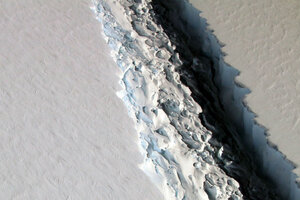Can scientists crack the case of an Antarctic ice shelf's growing rift?
At 90 miles and counting, the Larsen C ice shelf crack just keeps growing. Could studying this unusual crack predict future ice movements?

This Nov. 10, 2016 aerial photo released by NASA shows a rift in the Antarctic Peninsula's Larsen C ice shelf. The fracture is now 90 miles long and a third of a mile deep, glaciologists told NPR.
John Sonntag/NASA/AP/File
Cracks in the ice shelf are par for the course. But one crack just keeps growing – and it has scientists hunting for answers.
In Antarctica’s Larsen C ice shelf, what started as a tiny crack in the 1960s has become a 90-mile rift nearly a third of a mile deep. Most of the change has occurred since 2014, when that crack suddenly began growing more rapidly. And unlike other cracks, which tend to stop opening at some point, this rift has continued to expand.
At first glance, climate change might appear to be the obvious answer. After all, warming air and water contributed to the demise of Larsen A and Larsen B, two ice shelves that lay to the north of Larsen C until they warmed and splintered in 1995 and 2002. But experts suggest that climate change may be more of a future concern than it is a present cause. And understanding the root cause of this crack may hold the key to predicting future ice movements.
"This is probably not directly attributable to any warming in the region, although of course the warming won't have helped," Adrian Luckman, a glaciologist at Swansea University in Britain, told NPR. "It's probably just simply a natural event that's just been waiting around to happen."
Ice shelves are sheets of ice, attached to land, that are floating out at sea. As glaciers and ice streams flow into the shelf, it extends farther out to sea. But because the ice is brittle, it tends to crack, and over time, sections of the ice splinter off in a process known as “calving.” This process is “just part of life for an ice shelf,” Ala Khazendar, of NASA’s Jet Propulsion Laboratory, said in a NASA release.
Typically, however, only small sections of the ice would splinter off at any one time. The reasons for this are unclear, but scientists suggest several possible explanations. Different ice flows feeding the sheets move at different speeds, but in some areas, these flows come together. As a result, ice in that area becomes so fractured that there is no obvious path for a large crack.
In other cases, the cracks may hit marine ice, which forms on the bottom of the ice sheet. Marine ice is warmer and more flexible than the ice sheet, Dr. Khazendar told NASA’s Earth Observatory, meaning that it bends rather than breaking.
But the 90-mile crack in Larsen C has managed to overcome these obstacles, leaving researchers hunting for an alternative explanation. Khazendar suggested that the marine ice itself may have melted away, allowing the crack to meet up with pre-existing cracks in the bottom of the ice sheet.
Determining how this piece of ice – which NPR reported is now approximately the size of Delaware – managed to splinter off so dramatically is a key objective for glaciologists, who are meeting in Britain to discuss the crack this week.
"We need to get to the bottom of understanding what changed that allowed this rift to progress as it has, and will other rifts follow suit," Dan McGrath, a glaciologist at Colorado State University, told NPR.
Though experts are divided on whether all of Larsen C will ultimately separate from the mainland, and what will happen if it does, ice shelves are “gatekeepers for glaciers,” according to NASA. When they disappear, “glacial ice enters the ocean faster and accelerates the pace of global sea level rise.”
Understanding what caused this rift may allow scientists to predict – and prepare for – future ice movements. And although climate change may not be a primary cause this time around, it could come into play if this iceberg finally separates.
"The removal of a large chunk of ice may make the ice shelf more vulnerable to the effects of climate change in the future," Martin O'Leary, a member of Project MIDAS, a British project that studies ice melt, told Voice of America.

